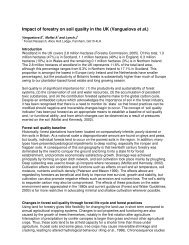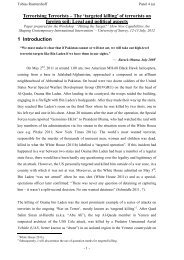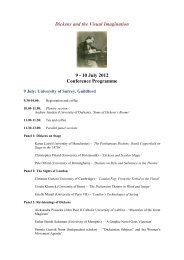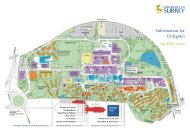Simulation of Network Enabled Weapons and SPEAR Strike ...
Simulation of Network Enabled Weapons and SPEAR Strike ...
Simulation of Network Enabled Weapons and SPEAR Strike ...
You also want an ePaper? Increase the reach of your titles
YUMPU automatically turns print PDFs into web optimized ePapers that Google loves.
<strong>Simulation</strong> <strong>of</strong> <strong>Network</strong> <strong>Enabled</strong><br />
<strong>Weapons</strong> <strong>and</strong> <strong>SPEAR</strong> <strong>Strike</strong><br />
Capabilities<br />
Mr. John Davis<br />
The Department <strong>of</strong> Electrical Engineering <strong>and</strong> Electronics<br />
Miss. Nicola Power<br />
The Department <strong>of</strong> Psychology<br />
Mr. James Davies<br />
The Department <strong>of</strong> Electrical Engineering <strong>and</strong> Electronics<br />
Dr. Jason Ralph<br />
The Department <strong>of</strong> Electrical Engineering <strong>and</strong> Electronics<br />
Pr<strong>of</strong>. Lawrence Alison<br />
The Department <strong>of</strong> Psychology
<strong>Simulation</strong> <strong>of</strong> <strong>Network</strong> <strong>Enabled</strong><br />
<strong>Weapons</strong> <strong>and</strong> <strong>SPEAR</strong> <strong>Strike</strong><br />
Capabilities<br />
Mr. John Davis<br />
The Department <strong>of</strong> Electrical Engineering <strong>and</strong> Electronics<br />
Miss. Nicola Power<br />
The Department <strong>of</strong> Psychology<br />
Mr. James Davies<br />
The Department <strong>of</strong> Electrical Engineering <strong>and</strong> Electronics<br />
Dr. Jason Ralph<br />
The Department <strong>of</strong> Electrical Engineering <strong>and</strong> Electronics<br />
Pr<strong>of</strong>. Lawrence Alison<br />
The Department <strong>of</strong> Psychology
Disclaimer<br />
• I am an Engineer…
Contents<br />
• Background<br />
• Simulating <strong>Network</strong>ed Weapon Systems<br />
• The Remote Operator Terminal<br />
• The Launch Acceptability Region<br />
• The Re-Tasking Acceptability Region<br />
• Testing Decision Making
Background<br />
• <strong>SPEAR</strong><br />
– Selective Precision Effects at Range (<strong>SPEAR</strong>) is the Ministry <strong>of</strong> Defence’s<br />
(MoD) research <strong>and</strong> development request for highly accurate, beyond visual<br />
range re-targetable weapons which can receive target information updates<br />
over a data-link (network) in near real-time as part <strong>of</strong> the UK’s “<strong>Network</strong><br />
<strong>Enabled</strong> Capability” (NEC) [1] .<br />
• NEC<br />
– “<strong>Network</strong> <strong>Enabled</strong> Capability (NEC) <strong>of</strong>fers decisive advantage through the<br />
timely provision <strong>and</strong> exploitation <strong>of</strong> information <strong>and</strong> intelligence to enable<br />
effective decision-making <strong>and</strong> agile actions. NEC will be implemented<br />
through the coherent <strong>and</strong> progressive development <strong>of</strong> Defence equipment,<br />
s<strong>of</strong>tware, processes, structures, <strong>and</strong> individual <strong>and</strong> collective training<br />
underpinned by the development <strong>of</strong> a secure, robust <strong>and</strong> extensive network<br />
<strong>of</strong> networks.” [2]<br />
1: Defence Research 2009 Annual Conference <strong>and</strong> Exhibition. UK Ministry <strong>of</strong> Defence. Birmingham.<br />
2: Ministry <strong>of</strong> Defence. Joint Service Publication 777 – <strong>Network</strong> <strong>Enabled</strong> Capability. MoD 2006.
Background<br />
• Current state <strong>of</strong> <strong>SPEAR</strong><br />
– <strong>SPEAR</strong> Cap 1: Paveway Guided Bomb<br />
– <strong>SPEAR</strong> Cap 2: Powered Missile<br />
– <strong>SPEAR</strong> Cap 3: Requirement for retargeting via data links.<br />
• MoD research on fitting PGB <strong>and</strong> Powered Missiles with data links has<br />
already been carried out.<br />
• Not unreasonable that the MoD might try to retr<strong>of</strong>it data link capabilities<br />
into existing systems.
Simulating <strong>Network</strong>ed Weapon Systems
Why we are doing this<br />
• To investigate:<br />
– Whether <strong>and</strong> how these systems can be used safely <strong>and</strong> reliably!<br />
– Improve the ability <strong>of</strong> the operator <strong>and</strong> pilot to make the correct decisions in<br />
the time required.<br />
– Providing methods to reduce the risk <strong>of</strong> collateral damage.
Simulating <strong>Network</strong>ed Weapon Systems<br />
• Setup<br />
– Weapon – Generic Guided Bomb Unit (GBU)<br />
– Delivery Mechanism – Tornado GR4 (Piloted)<br />
– Target – Generic SAM Launcher<br />
– Intelligence Source – MQ-9 Reaper UAV Video Feed<br />
– Remote Operator - HUMAN<br />
• <strong>Simulation</strong> S<strong>of</strong>tware:<br />
– Aircraft <strong>Simulation</strong> – FlightLAB (ART) & X-Plane 10<br />
– Visualisation Suite – X-Plane 10<br />
– Weapon <strong>Simulation</strong> – MATLAB<br />
– <strong>Network</strong>ing – Visual Studio & MATLAB
Simulating <strong>Network</strong>ed Weapon Systems<br />
• FlightLAB Aircraft Simulator
Simulating <strong>Network</strong>ed Weapon Systems<br />
• Avionics Testbed Facility
Simulating <strong>Network</strong>ed Weapon Systems<br />
• GBU Weapon Model
Remote Operator Terminal
Remote Operator Terminal<br />
Tornado GR4 Fast-Jet<br />
Attack Aircraft<br />
MQ-9 Reaper UAV<br />
Intelligence: Eyes on Target<br />
GBU<br />
Guided Free-fall Weapon<br />
Remote Operator Terminal
Remote Operator Terminal<br />
• Video Stream <strong>and</strong> Control Window
Remote Operator Terminal<br />
• Map Window
Launch Acceptability Region (LAR)
LAR<br />
Optimum - Ballistic<br />
Minimum Range<br />
Maximum Range<br />
Cross Range<br />
Reachable Set!
LAR<br />
• In Practice<br />
7km Min to Max Range<br />
30 Seconds at ~ 400kts
Re-tasking <strong>Weapons</strong><br />
The Re-Tasking Acceptability Region (RAR)<br />
NEW TARGET:<br />
Lat: 51.243370̊N<br />
Lon: 00.589538̊W<br />
Alt: 00060 Meters
RAR<br />
• Re-Tasking a Weapon<br />
Re-Task Requested
RAR<br />
• The Dynamics <strong>of</strong> RARs
RAR<br />
• The Dynamics <strong>of</strong> RARs
RAR<br />
• The Dynamics <strong>of</strong> RARs<br />
T = 0 seconds T = 22 seconds T = 26 seconds<br />
Release at ≈<br />
20’000ft<br />
Impact at 38<br />
seconds<br />
T = 27 seconds<br />
T = 31 seconds
Testing Decision Making
Testing Decision Making<br />
• The Sample Population’s Task:<br />
– To Correctly Re-Task or Deny a Re-Task Request dependant on<br />
whether the weapon will accurately hit the target.<br />
Re-Task<br />
O.K.<br />
Re-Task<br />
FAIL
Testing Decision Making<br />
• Variables<br />
– Distance <strong>of</strong> New Target from Original Target<br />
– Bearing <strong>of</strong> New Target from Original Target<br />
– Time From Launch <strong>of</strong> Re-Task Request
Testing Decision Making<br />
• Test Variables:<br />
– Speed at which the operator can make a decision to re-task the weapon?<br />
– Was it the correct decision?<br />
– What was their mood/stress level?<br />
– How confident were they that they made the correct decision?<br />
– How good was their situational awareness?
Testing Decision Making<br />
• Design the H.M.I. to help Operators make the “correct” decision.<br />
• Best way to display the collapse <strong>of</strong> the RAR to the Operator?<br />
• Types <strong>of</strong> Display:<br />
– RAR Area Plot on Map.<br />
– Moving Graph <strong>of</strong> Area % Remaining.<br />
– Maximum Reachable Range from Current Ballistic or On-Target Trajectory.<br />
– Projection <strong>of</strong> Future RAR on Map.
Summary<br />
• <strong>Simulation</strong> Suite <strong>of</strong> <strong>Weapons</strong> <strong>and</strong> Aircraft<br />
– GBU Weapon <strong>Simulation</strong><br />
– Fixed Wing Aircraft (Tornado, Typhoon, Jetstream etc)<br />
– Helicopters<br />
• Development <strong>of</strong> a General Remote Operator Terminal Successful<br />
– Moving Map<br />
– Live Video Feed<br />
– Verbal Communication <strong>Network</strong> (e.g. Radio)<br />
– Can Transmit Target Updates to Weapon<br />
– Overlay <strong>of</strong> LAR <strong>and</strong> RAR regions along with asset <strong>and</strong> target locations<br />
• Moving into Trials<br />
– Testing Decision Making <strong>of</strong> Remote Operators <strong>of</strong> <strong>Network</strong>ed <strong>Weapons</strong>
Thank You<br />
John Kenneth Davis - Email: j.k.davis@liv.ac.uk<br />
Centre <strong>of</strong> Autonomous Systems Technology (CAST)<br />
http://www.csc.liv.ac.uk/~michael/Centre_for_Autonomous_Systems_Technology/CAST%40<br />
liverpool.ac.uk.html
















